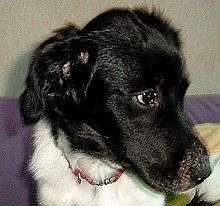Canine juvenile cellulitis
The puppy strangles (Syn. Juvenile sterile granulomatous dermatitis and lymphadenitis , engl. Puppy strangles ) is a skin disease of the dog of unknown cause. It occurs mainly in young dogs and manifests itself in pustules and nodules , especially on the face and auricles, as well as swelling of the lymph nodes. It is treated with high-dose glucocorticoids .
Occurrence and cause
Canine juvenile cellulitis is most common in puppies between three weeks and four months of age. More commonly affected breeds are Golden Retrievers , Dachshunds , Gordon Setters , Labrador Retrievers , Lhasa Apso, and Bolonka Zwetna . Occurrence in certain breeds and related animals suggests a genetic component. It is likely an immune system disorder.
Occasionally older dogs are also affected. In a larger study, individual cases of disease were found in animals between the ages of one and eleven years.
Clinical picture
Canine juvenile cellulitis begins with swelling of the face, especially around the lips and around the eyes, as well as the lower jaw and superficial cervical lymph nodes . One to two days later, papules or pustules appear that can burst and lead to the formation of crusts . The trunk or the external genital organs are also less often affected. Primarily there is no itching , but itching can also occur due to bacterial secondary infections .
Affected dogs are mostly beaten, but fever rarely occurs. Joint pain or paresis of the hind legs are also occasionally observed.
diagnosis
Cytologically , the disease manifests itself in a pyogranulomatous inflammation. There are accumulations of neutrophils , which are surrounded by macrophages arranged in an epithelial manner . The changes affect the entire skin and can extend to the subcutaneous tissue.
In the differential diagnosis, angioedema , demodicosis , pyoderma , drug eruption and lupus erythematosus can be excluded.
treatment
Treatment is with immunosuppressive doses of glucocorticoids . It should be done early to avoid excessive scarring. The dose and duration of treatment can vary widely. If necessary, the combination with cyclosporine can also be indicated. Antibiotics are only useful for secondary infections.
literature
- Susanne Massmann et al .: Canine juvenile cellulitis In: Kleintierpraxis 60 (2015), pp. 129–135.
Individual evidence
- ↑ A. Inga et al .: Sterile granulomatous dermatitis and lymphadenitis (juvenile cellulitis) in adult dogs: a retrospective analysis of 90 cases (2004-2018). In: Vet Dermatol. Volume 30, 2019, pp. 302-303.

